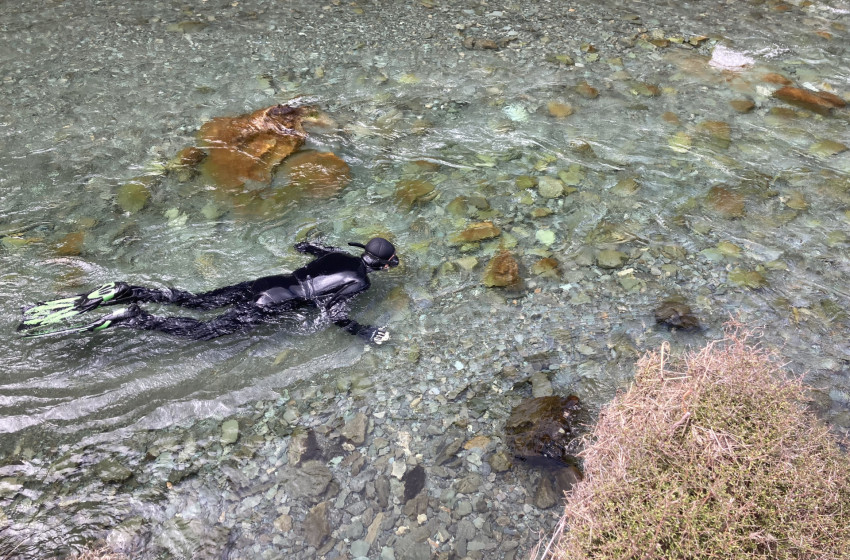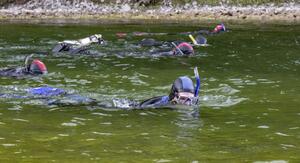River guardians back in the water
- Fresh Water Conservation
- 1/03/2023
- Roslyn Simmonds

Fish & Game has launched a diving programme to monitor New Zealand’s trout populations and assess the health of the nation’s waterways.
Fish & Game staff equipped with diving gear will drift and glide down hundreds of kilometres of rivers across the country, recording water clarity and temperature, assess instream fish habitat, the number of native fish, algal growth and the various instream insects present.
Divers will explore well over 250km of waterways, covering around 100 different rivers throughout the country.
The information from the trout population surveys will be used to help set catch limits for anglers.

North Canterbury and Central South Island Fish & Game officers drift dive the Hurunui River in Canterbury. Photo: Richie Cosgrove
Corina Jordan, Fish & Game New Zealand chief executive, says the programme highlights the important environmental monitoring role of the organisation.
“Drift diving enables us to give rivers a close-up health check. Combined with our assessment of the trout population -- the species that has the highest water quality requirement of any of New Zealand’s fish-- these observations will give us a good gauge on how healthy our rivers are.
“It is going to be interesting to see how the North Island rivers in particular have fared after Cyclone Gabrielle.”
Many regions have information dating back over 30 years, the longest running dataset of its kind, which can give valuable insight into the long-term trends of river health.
“No other organisation or government agency does more of this important type of monitoring of our waterways than Fish & Game,” says Ms Jordan.
“It will give us unique insights into the interactions between trout and some of our native fish, such as eels, which co-exist quite happily.
“In fact, it’s not uncommon for divers to see trout being eaten by eels, or trout with bite marks on them, which shows trout have become an important component of the food chain in many New Zealand rivers.”
The drift dive programme is expected to run until early April.
Fish & Game is a non-profit organisation that receives no government or taxpayer money, it is funded solely from the purchase of licences to fish for trout and salmon and hunt game birds.
What is ‘drift diving’?
Drift diving is a monitoring technique used to count trout or salmon within historical sites in river systems. Comparisons can be made between years to determine how the fishery is looking, and what factors are likely responsible for increase or decreases in fish numbers.
Most weeks over summer, when conditions are suitable (low river flows and clear water), you’ll find Fish & Game staff donning wetsuits and other assorted underwater gear and floating down a river counting trout, and, at the same time, categorising them into size cohorts and sometimes species.
Smaller rivers often only require two to four divers, however, larger rivers might need eight to 10 divers to ensure sufficient coverage.
Only fish that have swum past the divers are counted. Communication between divers is essential to make sure there are no double ups and all parts of the river are surveyed.
Most of the time the fish know the divers are coming and have retreated to the deepest part of a pool or are hiding under ledges. On some occasions they are pushed downstream and group up ahead of the divers, only to bolt through towards the tail of the pool, meaning some fast counting for the divers they flee past or between.
Regardless of the trout counts, drift diving is an important way to observe the general health of the river. Habitat qualities, invertebrate life, substrate, algal levels, native fish observations, and water clarity are all best seen through an underwater lens. At times, this information can aid Fish & Game’s advocacy functions, especially as many rivers are dived annually and have records dating back to the 1980s.
Divers also see some impressive fish, giant trout and salmon specimens. Some of the endemic longfin eels encountered have been on earth longer than we have and demand nothing but admiration and respect, with the occasional one giving the divers a good hurry up if they venture too close.